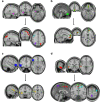Effect of lithium administration on brain activity under an emotion regulation paradigm in healthy participants: a functional magnetic resonance imaging study
- PMID: 37338568
- PMCID: PMC10349753
- DOI: 10.1007/s00213-023-06395-7
Effect of lithium administration on brain activity under an emotion regulation paradigm in healthy participants: a functional magnetic resonance imaging study
Abstract
Rationale: Emotion regulation (ER) difficulties have been previously described in bipolar disorder (BD). Whilst lithium has been shown to be effective in the treatment of BD, the mechanisms underlying lithium's effect on mood stabilisation remain unclear.
Objectives: Unravelling lithium's effect on psychological processes impaired in BD, such as ER, could address this translational gap and inform the development of new treatments.
Methods: This study investigated the neural effects of lithium (800mg) on ER in 33 healthy volunteers in a double-blind between-groups design, randomised to lithium (n=17) or placebo (n=16) for 11 days. At treatment completion, participants underwent 3-Tesla fMRI scan whilst performing an ER task.
Results: Reappraisal reduced negative affect across groups and led to the expected increase in frontal brain activity. Participants receiving lithium showed (1) decreased activation in prefrontal and posterior parietal cortices and connectivity between the fronto-limbic network (Z>2.3, p<0.05 corrected); and (2) increased activity in the right superior temporal gyrus (Z>3.1, p<0.05 corrected) and connectivity between the right medial temporal gyrus (MTG) and left middle frontal gyrus (Z>2.3, p<0.05 corrected) during reappraisal. Further effects of lithium were found in response to negative picture presentation, whereby an anticorrelation was found between the left amygdala and the frontal cortex, and greater connectivity between the right MTG and the bilateral medial prefrontal cortex extending into the paracingulate gyrus, compared to placebo (Z>2.3, p < 0.05 corrected).
Conclusions: These results show a potential effect of lithium on ER through its effects on activity and connectivity, and further elaborate the neural underpinnings of cognitive reappraisal. Future work should investigate longer term effects of lithium on ER in BD, ultimately benefitting the development of novel and more effective treatments.
Keywords: Emotional processing; Emotional regulation; Lithium; Task fMRI.
© 2023. The Author(s).
Conflict of interest statement
CJH has received consultancy fees from P1vital Ltd., Janssen Pharmaceuticals, Sage Therapeutics, Pfizer, Zogenix, Compass Pathways, and Lundbeck. CJH holds grant income from Zogenix, UCB Pharma, Pfizer, Janssen Pharmaceuticals.
Figures




Similar articles
-
Altered frontal-amygdala effective connectivity during effortful emotion regulation in bipolar disorder.Bipolar Disord. 2018 Jun;20(4):349-358. doi: 10.1111/bdi.12611. Epub 2018 Feb 11. Bipolar Disord. 2018. PMID: 29430790
-
Differential involvement of frontoparietal network and insula cortex in emotion regulation.Neuropsychologia. 2021 Oct 15;161:107991. doi: 10.1016/j.neuropsychologia.2021.107991. Epub 2021 Aug 12. Neuropsychologia. 2021. PMID: 34391808
-
Hemodynamic correlates of emotion regulation in frontal lobe epilepsy patients and healthy participants.Hum Brain Mapp. 2023 Mar;44(4):1456-1475. doi: 10.1002/hbm.26133. Epub 2022 Nov 10. Hum Brain Mapp. 2023. PMID: 36366744 Free PMC article.
-
Association Between the Fronto-Limbic Network and Cognitive and Emotional Functioning in Individuals With Bipolar Disorder: A Systematic Review and Meta-analysis.JAMA Psychiatry. 2023 May 1;80(5):432-440. doi: 10.1001/jamapsychiatry.2023.0131. JAMA Psychiatry. 2023. PMID: 36988918 Free PMC article.
-
Limbic and cortical regions as functional biomarkers associated with emotion regulation in bipolar disorder: A meta-analysis of neuroimaging studies.J Affect Disord. 2023 Feb 15;323:506-513. doi: 10.1016/j.jad.2022.11.071. Epub 2022 Nov 30. J Affect Disord. 2023. PMID: 36462610 Review.
Cited by
-
Emotion anticipation and processing in depression: Behavioral, neural, and physiological reactivity.Eur Psychiatry. 2025 Jun 11;68(1):e68. doi: 10.1192/j.eurpsy.2025.10043. Eur Psychiatry. 2025. PMID: 40495283 Free PMC article.
-
What is the effect of lithium use on the amygdalar volume of adult patients diagnosed with bipolar disorder: a scoping review.Ann Gen Psychiatry. 2024 Oct 24;23(1):38. doi: 10.1186/s12991-024-00523-z. Ann Gen Psychiatry. 2024. PMID: 39449057 Free PMC article.
-
Underlying biological mechanisms of emotion dysregulation in bipolar disorder.Front Psychiatry. 2025 May 9;16:1552992. doi: 10.3389/fpsyt.2025.1552992. eCollection 2025. Front Psychiatry. 2025. PMID: 40417273 Free PMC article. Review.
References
-
- American Psychiatric Association (2022) Bipolar and related disorders. In: Diagnostic and statistical manual of mental disorders, 5th edn, text rev. 10.1176/appi.books.9780890425787.x03_Bipolar_and_Related_Disorders - DOI
-
- Andersson JL, Jenkinson M, Smith S (2007a) Non-linear optimisation FMRIB technical report TR07JA1. Practice
-
- Andersson JL, Jenkinson M, Smith S. Non-linear registration, aka Spatial normalisation FMRIB technical report TR07JA2. FMRIB Anal Group Univ Oxford. 2007;2:e21.
Publication types
MeSH terms
Substances
Grants and funding
LinkOut - more resources
Full Text Sources
Miscellaneous

